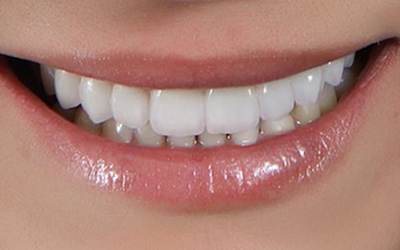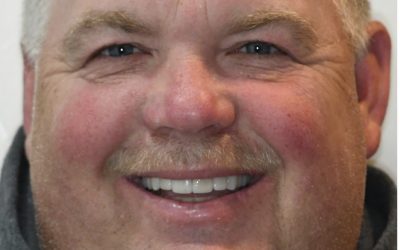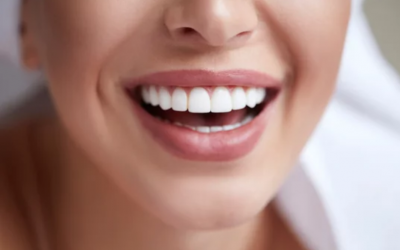As technology in dentistry continues to advance, there are more options than ever available to utilize in treating a patient’s dental needs. In addition, patients typically have a clear idea of what they want in terms of esthetics, and it is up to the clinician to orchestrate treatment in a way to provide the best treatment options while meeting the expectations of the patient. In most instances, the ideal treatment is to remain as conservative as possible while addressing all the issues presented with a particular patient. To do this, it can be necessary to include a multi-disciplinary team to ensure that each facet of the case is analyzed to achieve the optimum treatment.
Case report
At Opus One Laboratories, we are incredibly fortunate to work with clinicians like Dr. Sorin Muntean and work on challenging cases such as the one in this case report.
This 69-year-old patient presented with his chief complaints being an inability to properly chew food, difficulty flossing his lower front teeth, and pain on the lower left side. The initial step in treating this patient began with Dr. Muntean’s complete evaluation of his current situation. His medical history was determined to be non-contributory. He had been sporadic in his dental re-care appointments. Full mouth radiographs were taken, and these revealed that tooth #18 was fractured and severe bone loss was present interradicular of #19 and #30.
Visual Exam
The clinical visual exam demonstrated the following:
- Severe abrasion of the palatal upper anterior teeth and short lower anterior heights due to a restricted envelope of function.
- Large tori were visible on the mandible.
- #19 and #30 crown restorations were breaking down.
- Upper centrals were restored with porcelain jackets that were very long and completely covered the lower anterior incisors (deep class II).
- Severe crowding of the mandibular anterior teeth.
This initial appointment also resulted in an emergency extraction of tooth #18.



Bite Analysis
The patient was then examined to establish any potential issues related to his occlusion. It appeared that he had a normal range of opening. Both the immobilization test and loading tests produced no joint pain or muscle discomfort. No temporomandibular joint noises were present. This indicated that his TMJ was in a good healthy condition.
Next, Bimanual manipulation and a leaf gauge revealed identical records with pinpoint accuracy. This revealed that opening the bite in centric relation would be a viable option to increase the vertical dimension.
Treatment options
When prescribing any dental therapy, it is always recommended to look for treatment options that are as conservative as possible. The first option to consider in this case was orthodontic treatment. The patient was referred to an orthodontist for an evaluation. This evaluation resulted in a poor prognosis for tooth movement due to severe bone presence surrounding the affected teeth and the large mandibular tori.
The next option was to do a full lower reconstruction. This would entail opening the vertical dimension of occlusion (VDO). A full lower rehabilitation could have several different options to achieve the desired result in a case such as this. For this reason, it is advisable to seek the guidance of experts in each of the necessary disciplines to gain a unique perspective. As discussed above, this case was evaluated by an orthodontist to gain their insight, and also, the case was discussed with a dental surgeon to receive input on the possibility of extracting tooth number 23, 24, 25, 26.
Diagnostic Wax-up
Before making the final recommendation to the patient, a diagnostic wax-up was done to evaluate the given options and receive the valuable input of the Opus One Dental Laboratory team. This step involves looking at the patient’s desires, taking in the clinician’s direction, and then mocking this up through a dental wax-up. One of the directions discussed was whether to extract numbers 23, 24, 25, 26 as the patient did not like the overlapping of the lower anterior teeth. With an extraction, implants could be placed and with the proper design restored, without any overlapping. Through working up the wax-up, however, and in keeping with the idea to stay as conservative as possible, it was determined that with the proper preparation design, there would be no need to extract tooth numbers 23, 24, 25, 26.
Treatment
The final treatment plan then was to create implant restorations on #19 and #30. E.max full crowns were to be placed on numbers 22, 23, 24, 25, 26, and 27. E.max onlays/veneers were to be placed on numbers 20, 21, 28 and 29. Crown lengthening was recommended on the four lower anterior teeth.
This treatment plan was presented to the patient. He was informed of the risks of possibly needing root canal treatment on the lower anterior teeth due to the preparation. The patient agreed to the treatment.
The case was then prepared using the preparation guidelines dictated by the diagnostic wax-up.

No root canals were needed. The patient was impressed using conventional impression-taking methods. Bites were taken, as well as a Kois Dento Facial Analyzer to ensure the proper horizontal is captured. The patient was temporized using a matrix from the wax-up. He was able to wear the proposed treatment and provide feedback as well as evaluate and fine-tune the bite.
The case was mounted on a Panadent adjustable articulator. The vertical dimension was increased by approximately 2mm according to the approved wax-up. Custom abutments were designed on numbers 19 and 30. Zirconia screw-retained layered crowns were then fabricated to restore the abutments. E.max onlay/veneers were fabricated for numbers 20, 21, 28, 29. E.max pressed full crowns were fabricated for numbers 22, 23, 24, 25, 26, 27.


The units were pressed using HT A2 E.max ingots. The final shade was a 3M2.



The patient was extremely happy with the results both in terms of esthetics and function. With all the technology available, there are more treatment options available today than ever before. There is no question that in treating this patient, the input of several disciplines orchestrated by Dr. Muntean exceeded the patient’s desires while providing exceptional dental therapy.


Recent Opus News:
The Importance of Utilizing The Kois Facial Analyzer
In dentistry, there have always been challenges in transferring patient oral information to mount models accurately. The key to patient satisfaction is trying to minimize the need for adjustments as much as possible. Over the years, many tools have been developed to address the issues that occur regularly.
Using Time Tested Case Planning to Give Back to an American Hero
Opus One Laboratories has built its reputation on its expertise in handling large reconstruction cases and complex cosmetic cases. We have been changing people’s lives since 2000. We were honored to be asked to participate in the Smiles for America program and help give a very deserving person a new smile.
Influencing the Success of Ceramic Restorations
Ceramic restorations are among the most readily used treatments for improving the esthetics of anterior and posterior teeth. These restorations have evolved over the years in terms of material selection and fabrication techniques. Even with these continued...




